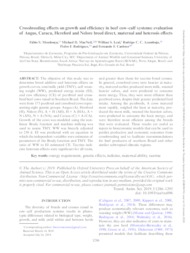Crossbreeding effects on growth and efficiency in beef cow-calf systems: evaluation of Angus, Caracu, Hereford and Nelore breed direct, maternal and heterosis effects.
Crossbreeding effects on growth and efficiency in beef cow-calf systems: evaluation of Angus, Caracu, Hereford and Nelore breed direct, maternal and heterosis effects.
Author(s): MENDONÇA, F. S.; MACNEIL, M. D.; LEAL, W. S.; AZAMBUJA, R. C. C.; RODRIGUES, P. F.; CARDOSO, F. F.
Summary: The objective of this study was to determine breed additive and heterosis effects on growth curves, total milk yield (TMY), calf weaning weight (WW), predicted energy intake (EI), and cow efficiency (CE) of purebred and crossbred beef cows raised in Southern Brazil. The data were from 175 purebred and crossbred cows representing eight genetic groups: Angus (A), Hereford (H), Nelore (N), A × H (AH), H × A (HA), A × N (AN), N × A (NA), and Caracu (C) × A (CA). Growth of the cows was modeled using the nonlinear Brody function and machine milking was used to assess TMY. WW was linearly adjusted to 210 d. EI was predicted with an equation in which the independent variables were estimates of parameters of the Brody function and TMY. The ratio of WW to EI estimated CE. Taurine?indicine heterosis effects were significant for all traits, and greater than those for taurine breed crosses. In general, crossbred cows were heavier at maturity, matured earlier, produced more milk, weaned heavier calves, and were predicted to consume more energy. Thus, they were more efficient than purebred cows, despite their greater predicted feed intake. Among the purebreds, A cows matured most rapidly, weighed the least at maturity, produced the most milk, weaned the heaviest calves, were predicted to consume the least energy; and were therefore most efficient among the breeds that were evaluated. These results are useful as inputs to bioeconomic models that can be used to predict productive and economic outcomes from crossbreeding and to facilitate recommendations for beef producers of southern Brazil and other similar subtropical climatic regions.
Publication year: 2019
Types of publication: Journal article
Keywords: Bezerro de Corte, Crescimento, Cruzamento, Gado de Corte, Genética Animal
Observation
Some of Embrapa's publications are published as ePub files. To read them, use or download one of the following free software options to your computer or mobile device. Android: Google Play Books; IOS: iBooks; Windows and Linux: Calibre.
Access other publications
Access the Agricultural Research Database (BDPA) to consult Embrapa's full library collection and records.
Visit Embrapa Bookstore to purchase books and other publications sold by Embrapa.

